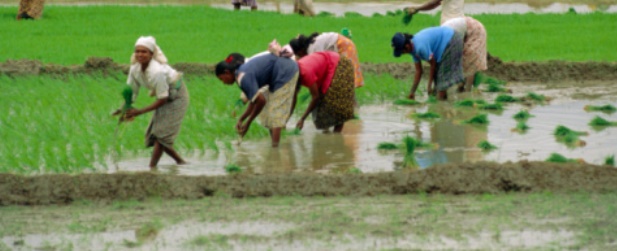Meera Srinivasan, The Hindu-
Rajapaksa’s appeal among the rural Sinhalese population cannot be underestimated. However, with Maithripala Sirisena crossing over, there is a likely split in the rural vote base
The joint opposition’s bid to give President Mahinda Rajapaksa a tough fight in the January 8 presidential polls has resulted in a rarely seen phenomenon in Sri Lanka — a contest between two candidates with their roots in the country’s rural heartlands.
In the past, it has mostly been a competition between a candidate from the urban elite and one from the rural areas. Mr. Rajapaksa, whose roots lie in Hambantota, the rural Sinhala heartland in the south, entered the fray in 2005 against former Prime Minister Ranil Wickramasinghe, very much a member of the Colombo elite.
Sirisena’s constituency
However, in the January 8 elections, Mr. Rajapaksa will face a serious challenge from Maithripala Sirisena, who hails from the Rajarata, a region that resounds with more than a millennium of Sinhala culture and history.
The historic belt — which includes the island’s ancient capital of Anuradhapura and Polonnaruwa that Mr. Sirisena represents in Parliament — is in the North Central province, where a majority of the population depends on agriculture for their livelihood. Mr. Sirisena, also from Mr. Rajapaksa’s party, left the government in November to be named common opposition candidate.
The votes cast by the Sinhalese electorate will be decisive, with the main parties representing the island’s minority Tamils and Muslims backing the common opposition candidate.
The rural Sinhala vote has traditionally gone to the Mr. Rajapaksa’s Sri Lanka Freedom Party (SLFP). However, Mr. Sirisena’s candidature is likely to split that vote base, says Sinha Ratnatunga, editor of the widely-read Sunday Times.
The dent in Mr. Rajapaksa’s vote bank seems all the more likely especially with former President Chandrika Bandaranaike Kumaratunga, whose father S.W.R.D. Bandaranaike founded the SLFP, endorsing Mr. Sirisena.
Her political comeback after nearly nine years has not only induced confidence into the disgruntled SLFP old guard — tired of Mr. Rajapaksa allegedly promoting his family — but also signalled a potential split in the SLFP base itself.
With the United National Party (UNP) too backing him, it is the support of Ms. Kumaratunga and the traditional rural vote bank of the SLFP defectors that is expected to make up for the UNP’s weakness in rural constituencies.
The UNP, the main Opposition, has also not been entirely detached from the rural electorate, according to Kumudu Kusum Kumara, senior lecturer at Colombo University’s sociology department.
Some of its populist leaders have in the past come up with some “pro-poor policies” targeting the peasants, he argues. “But that image changed after the economy was opened up in 1977 under President J. R. Jayewardene’s leadership. More so after his protégé Ranil Wickramasinghe came to the helm,” he says.
That helped Mr. Rajapaksa drum up support among rural Sinhalese, particularly with his “war victor” trophy. After two successive terms, his appeal among the rural Sinhalese population cannot be underestimated. To them, he is that mighty leader who crushed the rebel Tigers and brought peace to their country.
Among this rural Sinhala population, particularly in southern Sri Lanka, Mahinda Rajapaksa has always had the support of women.
“They see him as the macho leader who saved their country by bringing the brutal war to an end,” says Mr. Ratnatunga, explaining their apparent loyalty to the incumbent.
Livelihood concerns
While rising costs, concerns over employment and livelihoods dominate rural Sri Lanka, including in the Sinhala heartland, it remains to be seen if issues like corruption and rising authoritarianism — some of the key campaign points of the joint opposition — will resonate with the average rural Sinhalese voter, he notes.
The government camp in its election rhetoric repeatedly flaunts its development thrust — plush expressways, ports and airports — but Sinhala youth appear to be following the implications of development keenly, whether in their own hometowns or in the cities they may work in. “They seem a little more sceptical of the development projects and tend to question them,” says Mr. Ratnatunga.
Urban-rural divide
Moreover, the rural youth are increasingly landing jobs in the city. The urban-rural divide does not necessarily stop them from understanding the nature of disparity, according to Mr. Kusum Kumara. “Many of them work in the cities and go back to their villages during the weekends. They are very much aware of the realities.”
According to him, there is a clear momentum in the rural and urban constituencies swinging in favour of the joint opposition. “This is a crucial, decisive, do-or die election for us.”
All the same, sections believe the momentum may very well be confined to urban areas. It is still not clear whether the opposition campaign has made any significant inroads into Mr. Rajapaksa’s core constituency of the rural Sinhalese voters, observed Jayadeva Uyangoda, professor of political science at the University of Colombo, in a recent article.
Whether Sri Lanka’s rural Sinhalese like Mr. Rajapaksa enough to give him a third term will be known in about a week from now.
(This is the first of a three-part series.)
[Original image: Getty images]
The Hindu
